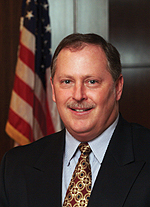What the Future Bears

This edition of Ingram's is interesting as it outlines the major infrastructure improvements and projects that will either soon begin or are presently under construction throughout the region--I think you'll be surprised at just how much development is occurring.
Every few years we explore the possibilities of what the future of Kansas City bears. This column explores a few concepts that I believe merit consideration. The Millennium edition of Ingram's included a fully integrated mass transit plan to connect the expansion communities on the periphery of the market and most of them within it.
Two years later we presented a concept to Senator Kit Bond and several other top state officials in Missouri that included a high speed heavy rail system to connect key markets and sports facilities in an east-west axis from Topeka on the west to the Illinois side of the metropolitan St. Louis area on the east. The design includes limited access to high speed heavy rail service that would swiftly move pedestrians along the I-70 corridor.
The plan was conceived in conjunction with a statewide effort to host a potential, future Summer Olympics in the state of Missouri with the University of Missouri-Columbia serving as the central Olympic venue and benefactor of the enhanced facilities. The idea that we could utilize two international airports (KCI and Lambert) within a two-hour drive and an hour by rail supplemented by an enhanced Columbia National Airport (currently Columbia Regional Airport) made logical sense. This would also serve to align the interests of the entire state and our land grant university.
The concept would tie together the sports facilities along this east-west axis, including KU's Memorial Stadium, Kansas Speedway at Village West, Kemper Arena, a new downtown KC arena (Sprint Center), Truman Sports Complex, Faurot Field and Paige Sports Arena in Columbia, Keil Auditorium, and St. Louis' new state-of-the art football stadium. I know this sounds a bit ambitious, but dreams always are.
Back to the Present
The logistics of our present infrastructure coupled with our centrality at the nexus of North American trade, particularly in the Kansas City area, could yield some dynamic expansion opportunities. It's easy to substantiate why the Kansas City area should become one of America's most desired destinations. Its centrality, cost of living, work force, unimpeded growth potential, and the clout of two state governments are just a few of our assets.
While We're Dreaming
In not such a distant future the metro region will harness the concept of implementing a tax mechanism, unlike the Think Big campaign, that will yield equitable benefits to each area county. I happen to think that, despite Kansas City being the nations' most auto-friendly market, the most logical initiative will take the form of an integrated transportation system.
In addition to the heavy rail service along a proposed six-lane toll road to St. Louis, it's important that we devise a light rail system with the Sprint Center (a logical name for a transit station) to serve as the central transportation hub.
Service would begin in the city of Leavenworth with connections at KCI through the Northland and into the Sprint Center in Downtown Kansas City. The same line would continue southeast along the Bruce Watkins/Hwy. 71 corridor (without the impeding stop lights) to a corporate headquarters campus developed around the Grandview Triangle and into the Richards-Gebaur Air Reserve Station.
The cross axis would begin at NewCentury AirCenter in Gardner and travel along the I-35 corridor through Olathe, Lenexa, Overland Park and each of the relevant communities of Johnson and Wyandotte counties into downtown. Going north, the route continues along the I-35 route through Liberty and into the redeveloped Clay County Airport that is ramping up for expanded service now. "Kansas City's Crossroads" transportation system could be the envy of all American cities and is realistic enough to generate bi-state enthusiasm.
Before you dismiss this concept as too far-fetched, please read this issue, particularly the ‘Kansas City's Crossroads Culture' feature on page 41 and the ‘New Developments' feature on page 57. Remember that all of these noted projects will be built (or begun) within the next five years. What most people don't realize is just how much development is now occurring.
Ideally, the business community and area governments will comprehend the magnitude of the projects now in motion and ‘think out of the box' as to what our ensuing steps should be. The Kansas City area will yield far more potential if we genuinely work together and devise a master plan for the future of our unified region.
We hope you enjoy this very special edition of Ingram's . Regards,